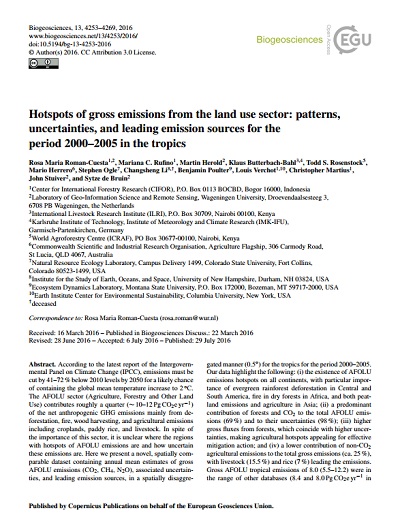Resource information
According to the latest report of the Intergovern- mental Panel on Climate Change (IPCC), emissions must be cut by 41–72 % below 2010 levels by 2050 for a likely chance of containing the global mean temperature increase to 2 ?C. The AFOLU sector (Agriculture, Forestry and Other Land Use) contributes roughly a quarter (? 10–12 Pg CO2 e yr?1 ) of the net anthropogenic GHG emissions mainly from de- forestation, fire, wood harvesting, and agricultural emissions including croplands, paddy rice, and livestock. In spite of the importance of this sector, it is unclear where the regions with hotspots of AFOLU emissions are and how uncertain these emissions are. Here we present a novel, spatially com- parable dataset containing annual mean estimates of gross AFOLU emissions (CO2 , CH4 , N2 O), associated uncertain- ties, and leading emission sources, in a spatially disaggre-gated manner (0.5?) for the tropics for the period 2000–2005. Our data highlight the following: (i) the existence of AFOLU emissions hotspots on all continents, with particular impor- tance of evergreen rainforest deforestation in Central and South America, fire in dry forests in Africa, and both peat- land emissions and agriculture in Asia; (ii) a predominant contribution of forests and CO2 to the total AFOLU emis- sions (69 %) and to their uncertainties (98 %); (iii) higher gross fluxes from forests, which coincide with higher uncer- tainties, making agricultural hotspots appealing for effective mitigation action; and (iv) a lower contribution of non-CO2 agricultural emissions to the total gross emissions (ca. 25 %), with livestock (15.5 %) and rice (7 %) leading the emissions. Gross AFOLU tropical emissions of 8.0 (5.5–12.2) were in the range of other databases (8.4 and 8.0 Pg CO2 e yr?1 in FAOSTAT and the Emissions Database for Global Atmo- spheric Research (EDGAR) respectively), but we offer a spa- tially detailed benchmark for monitoring progress in reduc- ing emissions from the land sector in the tropics. The location of the AFOLU hotspots of emissions and data on their as- sociated uncertainties will assist national policy makers, in- vestors, and other decision-makers who seek to understand the mitigation potential of the AFOLU sector.


